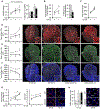A DGKζ-FoxO-ubiquitin proteolytic axis controls fiber size during skeletal muscle remodeling
- PMID: 29764991
- PMCID: PMC6201691
- DOI: 10.1126/scisignal.aao6847
A DGKζ-FoxO-ubiquitin proteolytic axis controls fiber size during skeletal muscle remodeling
Abstract
Skeletal muscle rapidly remodels in response to various stresses, and the resulting changes in muscle mass profoundly influence our health and quality of life. We identified a diacylglycerol kinase ζ (DGKζ)-mediated pathway that regulated muscle mass during remodeling. During mechanical overload, DGKζ abundance was increased and required for effective hypertrophy. DGKζ not only augmented anabolic responses but also suppressed ubiquitin-proteasome system (UPS)-dependent proteolysis. We found that DGKζ inhibited the transcription factor FoxO that promotes the induction of the UPS. This function was mediated through a mechanism that was independent of kinase activity but dependent on the nuclear localization of DGKζ. During denervation, DGKζ abundance was also increased and was required for mitigating the activation of FoxO-UPS and the induction of atrophy. Conversely, overexpression of DGKζ prevented fasting-induced atrophy. Therefore, DGKζ is an inhibitor of the FoxO-UPS pathway, and interventions that increase its abundance could prevent muscle wasting.
Copyright © 2018 The Authors, some rights reserved; exclusive licensee American Association for the Advancement of Science. No claim to original U.S. Government Works.
Figures







References
-
- Evans WJ, Skeletal muscle loss: Cachexia, sarcopenia, and inactivity. Am. J. Clin. Nutr. 91, 1123S–1127S (2010). - PubMed
-
- Goldberg AL, Etlinger JD, Goldspink DF, Jablecki C, Mechanism of work-induced hypertrophy of skeletal muscle. Med. Sci. Sports 7, 185–198 (1975). - PubMed
-
- Srikanthan P, Karlamangla AS, Relative muscle mass is inversely associated with insulin resistance and prediabetes. Findings from the third National Health and Nutrition Examination Survey. J. Clin. Endocrinol. Metab. 96, 2898–2903 (2011). - PubMed
Publication types
MeSH terms
Substances
Grants and funding
LinkOut - more resources
Full Text Sources
Other Literature Sources
Molecular Biology Databases
Research Materials

